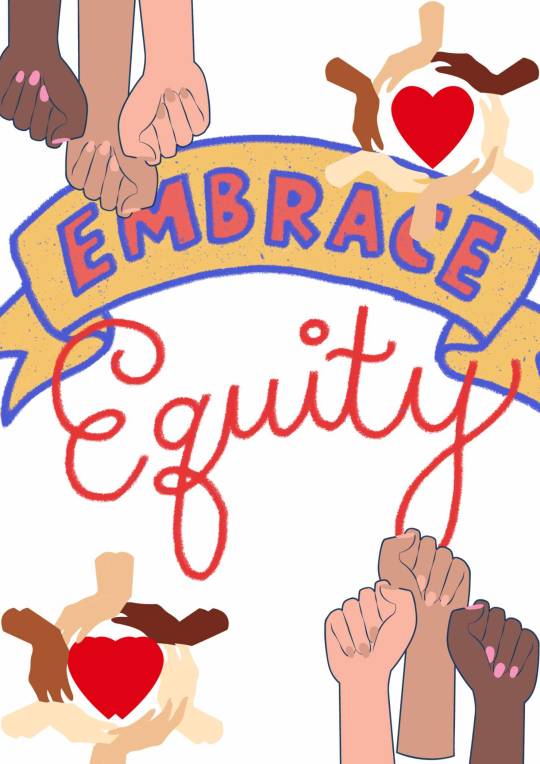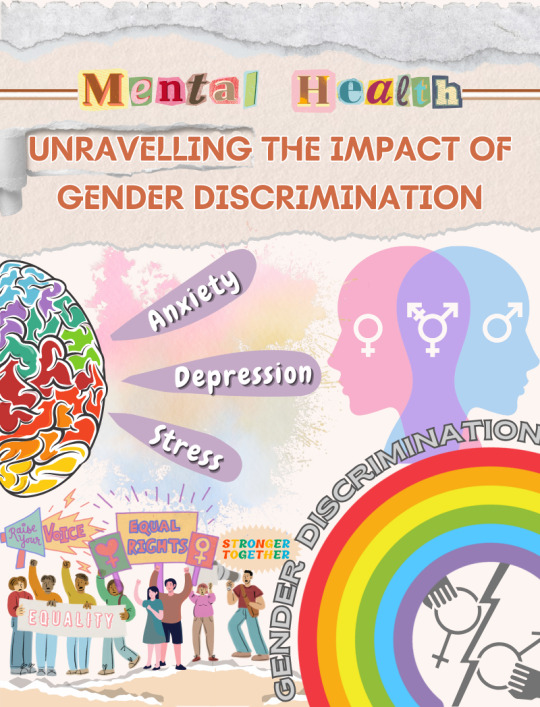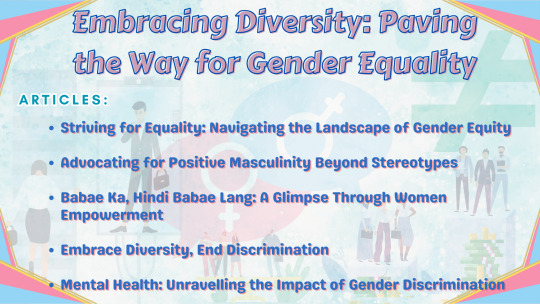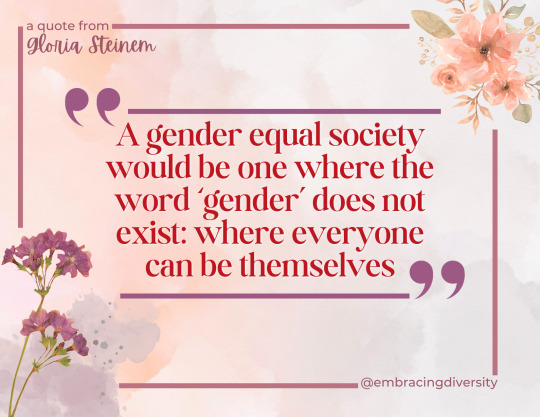Text
Striving for Equality: Navigating the Landscape of Gender Equity

We define gender equity as the fair treatment of women and men according to their respective needs. This may include equal treatment, or it may include treatment that is different but considered equivalent in terms of rights, benefits, obligations, and opportunities. Two guiding principles are at the core of gender equity: fairness and impartiality. Fairness has to do with just treatment without favoritism or prejudice, while impartiality is defined as treating all parties equally. Equity, in its simplest terms, means meeting communities where they are and allocating resources and opportunities as needed to create equal outcomes for all community members (find out more about the differences between equity and equality here). Gender equality does not mean that women and men will be treated the same; it means that women and men’s rights, responsibilities and opportunities will not be based upon their gender. Gender Equality may involve the use of temporary special measures to compensate for historical or systematic bias or discrimination. It refers to differential treatment that is fair and positively addresses a bias or disadvantage that is due to gender roles or norms or differences between the sexes.
Gender equity is important improves opportunities for all and allows people to pursue their dreams despite gender. By promoting gender equity, we can create a society that is inclusive and diverse, where everyone has an equal chance to succeed. Gender equity ensures that everyone is treated fairly and with respect, regardless of their gender identity. It helps to break down gender stereotypes and biases, which can limit people’s potential and prevent them fro achieving their goals. Below are some several benefits of gender equity.
Work places a work environment that welcomes diversity of thought and is free from inequities improves life satisfaction for women and men.
Health care related to gender equity, because of the medical profession has favored the male anatomy in research and education. Yet to this day, doctors are more likely to dismiss a woman’s physical pain as being mental, emotional or even suggest that the patient is a hypochondriac.
Another crucial aspect where gender equity plays a significant role is in healthcare. Historically, medical research and have predominantly focused on the male anatomy, often neglecting the unique health needs and experiences of women. This bias has resulted in the women’s physical pain being dismissed or attributed to psychological factors, leading to delayed or inadequate medical treatment. By promoting gender equity in health care, medical professionals can address. These disparities and ensure that women receive the same level of care attention as men. This involves recognizing and addressing gender-based biases, providing comprehensive and gender sensitive healthcare services, and empowering women to make informed decisions about their own health. Women and men alike benefit from such inclusive workplaces, as they can freely express their ideas, contribute to decision making processes, and have equal access to career advancement opportunities. This not only job satisfaction but also promotes overall life satisfaction foe individuals, as they are able to pursue their professional aspirations without being hindered by gender based or discrimination.
Here are some examples of Gender Equity:
Economic independence
Freedom of clothing
Creation of job training programs for women in vulnerable situations
Implementation of educational programs for women, with an emphasis on an area where there is a gender gap, such as entrepreneurship, finance or technology
Eliminating gender stereotypes in advertising
Paternity leave, which allows parents to accompany their partners when they have had a baby
Legal protection and political voice
The right to vote of both sexes
Same job opportunities
Written by: Angel Eroa
Pubmat by: Angel Eroa
Reference
United Way of the National Capital Area. (2023, April 19). What is gender equity? Definition & Examples | United Way NCA - United Way NCA. United Way NCA. https://unitedwaynca.org/blog/what-is-gender-equity/
0 notes
Text
Advocating for Positive Masculinity Beyond Stereotypes

In an ever-changing world, our understanding of gender roles and identities must evolve as well. Healthy masculinity is a notion that transcends stereotypes and challenges the standard narrative of masculinity. It is a paradigm shift that invites us to reconsider and modify our ideas about what it means to be a guy.Promoting positive masculinity emerges as a progressive force seeking to reshape old values. This campaign focuses on encouraging men to embody attributes like empathy, emotional intelligence, and vulnerability in addition to traditional features, building a more inclusive and enlightened definition of masculinity. It is a cry to break away from confining preconceptions, allowing men to honestly express their entire spectrum of emotions and attributes.
This movement aims to build a culture that embraces the diversity of male identities by opposing harmful conventions, resulting in healthier people and communities. Fostering positive masculinity shines as an inspiration for hope in a culture filled with stereotypes. It encourages men to redefine strength through compassion and resilience through vulnerability. The act of doing so signifies a transformative journey, removing barriers to honesty and developing a culture in which every man may succeed honestly.Promoting positive masculinity is a crucial advocacy endeavor aimed at redefining societal expectations and fostering healthier behaviors among men. The primary objectives involve challenging harmful stereotypes, encouraging open communication, and promoting the concept that strength and resilience can coexist with vulnerability and emotional expression. By raising awareness through educational campaigns, workshops, and diverse portrayals of positive male role models, the advocacy seeks to break away from narrow definitions of masculinity. Emphasizing emotional intelligence and the importance of healthy relationships, the initiative encourages men to be active allies in dismantling toxic norms. Providing resources and support networks, collaborating with relevant organizations, and utilizing social media platforms are key strategies to amplify the impact of advocacy. Events, workshops, and seminars serve as platforms for discussions and the sharing of insights, contributing to a cultural shift towards positive masculinity.
The core mission is to dismantle toxic stereotypes and cultivate a more inclusive understanding of masculinity. By fostering open dialogue and challenging traditional expectations, the advocacy aims to empower men to express a full range of emotions and qualities without fear of judgment.Through positive role models and inclusive narratives, we aspire to showcase that strength can coexist with compassion and resilience with vulnerability. This advocacy envisions a society where men feel empowered to express their individuality, contribute to healthy relationships, and challenge stereotypes, ultimately paving the way for a more inclusive and understanding world. Changes in culture, community involvement, and education are all necessary to promote positive masculinity. Values are shaped by a variety of factors, including policy lobbying, gender equality, education, media representation, community conversations, mentorship programs, and mental health awareness. Positive masculinity values can be shaped from an early age by promoting emotional intelligence, maintaining good relationships, and having a varied range of male role models.To sum up, the path toward promoting positive masculinity entails a continuous dedication to rewrite histories, liberate ourselves from constrictive stereotypes, and cultivate a society that embraces the range of masculine characteristics. We are building the groundwork for a society in which every man can thrive in his true sense as we jointly confront harmful conventions, value variety, and place a high priority on empathy.
Written by: Glailey Sophia Malvar
Pubmat by: Glailey Sophia Malvar
References
Keyser, E. H. &. C. (2022, May 18). 3 Ways to Promote Positive Masculinity. Resonance Global. https://www.resonanceglobal.com/blog/how-to-promote-positive-masculinity
Williams, R. (2022, March 7). A call for positive masculinity. https://www.linkedin.com/pulse/call-positive-masculinity-ray-williams
0 notes
Text
Babae Ka, Hindi Babae Lang: A Glimpse Through Women Empowerment

Throughout the pages of history, the concept of gender has consistently emerged as a subject of profound societal preoccupation, warranting careful examination in the pursuit of national progress. Furthermore, this study illuminates the manner in which cultural norms and social stratification exert influence over the representation and access to various opportunities for distinct cohorts of males and females (Nirola, 2018). Undoubtedly, historical evidence substantiates the notion that women consistently exhibit resilience and resourcefulness in times of adversity. Moreover, it reveals that women have significantly contributed to the advancement of human society to a greater extent than their male counterparts.
Nevertheless, the enduring presence of patriarchy within society has been observed since antiquity, exerting a detrimental influence on the recognition and appreciation of women's contributions towards enhancing the well-being of individuals within patriarchal societies such as the Philippines. Undoubtedly, women are consistently subjected to numerous sorts of oppression. Yet, there is currently a notable trend towards the advancement of women's empowerment within the present era. While women have consistently exhibited strength, their resilience has further intensified, leading them to actively advocate for one another without hesitation (International Women’s Day 2022: “Gender Equality Today for a Sustainable Tomorrow,” 2021).
“Abante Babae! Palaban militante!”
“The future is female.”
“The last man standing is a woman!”
The aforementioned terms are not unfamiliar to the Filipino population, as they have been previously encountered. Moreover, these gestures serve as deliberate actions aimed at enhancing the visibility of feminism throughout the nation. This strategic approach seeks to magnify the voices of women, thereby facilitating their advancement in society. Moreover, notwithstanding the increasing sense of empowerment experienced by women in contemporary society, the aforementioned words serve as a poignant reminder of the arduous nature of the ongoing struggle for gender equality that women face across all domains (University of Birmingham, 2015). In order to gain recognition, individuals must vocalize their concerns, engage in public displays of advocacy, and actively strive to assert their entitlements. Regrettably, they are also subject to persistent assault and abuse. Consider, for example, the phenomenon of prostitution, which is undeniably a manifestation of gender-based violence and a type of violence directed towards women. Prostitution, as opposed to other manifestations of gender-based violence, exhibits a distinctive characteristic whereby monetary transactions are involved in the perpetration of abuse. Nevertheless, it is important to note that the exchange of money does not entirely eradicate individuals' awareness of the dynamics surrounding sexual harassment, sexual abuse, and domestic violence (Farley, 2020). The likelihood of women engaging in prostitution is higher, and they are more prone to becoming victims of their own circumstances. This can be attributed to the fact that prostitution represents a visible expression of behavior that deviates from traditional gender norms. Consequently, individuals involved in prostitution face social exclusion, which results in the denial of esteemed status and associated benefits linked to societal norms. Therefore, it was imperative to put an end to the many forms of exploitation faced by women. It was crucial to empower women, enabling them to exercise autonomy in decision-making processes and ensuring they were not subjected to any form of manipulation.
Moreover, women encounter obstacles in numerous professions that are predominantly dominated by men, such as politics, academia, athletics, various legislative arenas, and diverse professional domains. In addition, women exhibit higher poverty rates compared to men on a global scale. Examining the distinct experiences of men and women in relation to poverty, as well as the substantial obstacles they encounter in accessing resources, economic prospects, and the benefits of representative democracy, enables policymakers to enhance the efficacy of poverty alleviation measures (Malhotra, 2009). The challenges encountered by the individuals in question are undeniably attributable to the presence of sexism and the perpetuation of gender stereotypes. Nevertheless, it is imperative for the global community to fulfill its commitments to feminism by actively promoting the empowerment of women and addressing their legitimate concerns pertaining to the attainment of equal rights. It is crucial to note that this call to action should not be misconstrued as a gender-based struggle between men and women, but rather as a collective effort to combat and eradicate discrimination. Feminism unequivocally constitutes a struggle against sexism rather than a struggle against men.
The phenomenon of sexism towards guys does indeed exist; nonetheless, it is important to acknowledge that men generally possess higher social standing and wield greater power than women in numerous nations. Consequently, any harm experienced by men is mostly an inadvertent outcome of gender discrimination predominantly targeting women. To ensure the ongoing development, empowerment, and leadership of women within their own cultures, it is imperative to currently prioritize and direct attention towards them. This implies that they must possess a concrete existence in the now, while also being unequivocally associated with the future. In order to progress, it is imperative for society to empower women to exercise autonomy over their lives, including the ability to make choices regarding their own bodies. The autonomy of individuals necessitates their unrestricted agency in decision-making, hence entitling them to exercise their freedom without external imposition. It is important to acknowledge that they are women, not just mere women
Written by: Stefhany Mae Robles
Pubmat by: Stefhany Mae Robles
References
Farley, M., PhD. (2020, November 16). Prostitution Is Sexual Violence. Psychiatric Times. https://www.psychiatrictimes.com/view/prostitution-sexual-violence
International Women’s Day 2022: “Gender equality today for a sustainable tomorrow.” (2021, December 3). UN Women – Headquarters. https://www.unwomen.org/en/news-stories/announcement/2021/12/international-womens-day-2022-gender-equality-today-for-a-sustainable-tomorrow
Malhotra, G. K. (2009). A Real Portrait of the Concept: Women Empowerment. SSRN Electronic Journal. https://doi.org/10.2139/ssrn.1462820
Nirola, B. (2018, November 26). Patriarchy And The Status Of Women In The Society. Youth Ki Awaaz. https://www.youthkiawaaz.com/2017/12/role-of-patriarchy-and-status-of-women-in-indian-society/
University of Birmingham. (2015, September 7). Understanding gender. GSDRC. https://gsdrc.org/topic-guides/gender/understanding-gender/
2 notes
·
View notes
Text
Embrace Diversity, End Discrimination

In today’s society, the LGBTQIA+ (lesbian, gay, bisexual, transgender, queer, questioning, intersex, or asexual) community is growing in every country as many people gain the courage to let their true identities out in public. The LGBT Pride survey conducted by the Independent Polling System Of Society (IPSOS) showed that an average of 3% of the participants from 27 countries aged 16-74 were part of the LGBTQIA+ community. In 2023, IPSOS stated that an average of 9% of the participants interviewed in the recently conducted LGBT Pride survey were part of the LGBTQIA+ community, thus increasing its members by 6% in two years. Because of the growing population of this community, many people think that they should be accepted in the society. As of 2019, 73% of 38,000 people in 34 countries agreed to accept homosexuality according to a Pew Research report.
Although the LGBTQIA+ community is becoming accepted and respected, some people still do not accept them. In the same Pew Research report, 24% of the people surveyed did not agree to accept homosexuality. This results in discrimination and hate crimes towards them. According to the Social Weather Stations survey in 2019, 60% of Filipinos believe that members of the LGBTQIA+ experience discrimination. Additionally, according to a report published by Statista Research Department, being a member of LGBTQIA+ is considered a crime in 71 countries, especially in the Middle East, Africa, and Asia. In some countries, like Saudi Arabia and Iran, the members of the LGBTQIA+ community are given the death penalty. Because of this, some people cannot let their true selves out.
Some forms of discrimination that the LGBTQIA+ community experiences are: rejection in job applications or employment, and/or discrimination in the workplace, insults, humiliation, bullying especially in students, not letting them inside establishments, harassment, or even murder. An article published by Human Rights Watch in 2017 narrated the experiences of some LGBTQIA+ students who experienced discrimination. For example, Carlos M., who at that time was a 19-year-old gay student at Olongapo City, experienced verbal and physical bullying at his school, saying that when he went in and out of the school, his schoolmates would push him, punch him, and call him things like gay or faggot. Marisol D., a 21-year-old student at Manila and a transgender woman, shared her experience when she was in high school, her teacher humiliated her by calling her in front and cutting her hair in front of the class.
A news report by ABS-CBN showed that members of the LGBTQIA+ community held a rally for the reason that they still experience discrimination. Val Evangelista and Harry Serrano are among the people who joined the rally due to their personal experiences of discrimination such as people asking unnecessary questions that feel insulting, still being called by their biological gender, and/or discriminatory stares of other people. LAGABLAB network stated that discrimination against LGBTQIA+ communities continue to happen because there are no official laws that protect their rights.
Because of this, it is be necessary to provide laws that protect the rights of the LGBTQIA+ community. For example, the Sexual Orientation and Gender Identity or Expression (SOGIE) Bill must be given attention by the Senate to help stop LGBTQIA+ discrimination in the soonest possible time. But for now, we must do something to stop discrimination and violence for all genders. The specific things we can do are to educate ourselves about sexuality and sexual violence, then we can educate others about this through social media especially through TikTok, or by simply opening up the topic to others. Next is to educate ourselves and others on how to stop sexual violence such as not tolerating sexually offensive jokes or rape jokes, speaking up against sexual violence, never tolerating any form of disrespect to all sexualities, and encouraging people to be open-minded about the fact that some people are just born into a male or female body but their gender is the opposite of the body that they are in. We can do this in the form of advocacies through blogs, especially in social media, we can create content about the concept of sexual violence and say NO to sexual violence, especially in TikTok. Also, we can let them know about the religious perspectives regarding the prohibition of rejection and violence of certain sexualities (because some people use religion as a reason for them to discriminate against some sexualities). For example, the Pope of the Catholic Church says that what Christianity teaches is to always welcome everyone in the Church, so we, as members of the Church, should always welcome, and we have no right to reject anyone or kick anybody out, even the Pope, as he said. These are some ways that I think we can do to stop sexual violence.
Written by: Samantha Gabrielle Tirana
Pubmat by: Samantha Gabrielle Tirana
References
ABS-CBN News. (2023, June 2). Ilang Pinoy na LGBTQ community members idinaing ang diskriminasyon | TV Patrol [Video]. YouTube. https://www.youtube.com/watch?v=aDMs3HzjEQQ
Topic: LGBTQ+ worldwide. (2023, August 31). Statista. https://www.statista.com/topics/8579/lgbtq-worldwide/#topicOverview
Abad, M. (2020, June 25). 73% of Filipinos think ‘homosexuality should be accepted by society’ – report. RAPPLER. https://www.rappler.com/nation/264862-filipinos-acceptance-homosexuality-2019-pew-research-report/
Thoreson, R. (2023). “Just let us be.” In Human Rights Watch. https://www.hrw.org/report/2017/06/22/just-let-us-be/discrimination-against-lgbt-students-philippines
1 note
·
View note
Text

0 notes
Text
Mental Health: Unravelling the Impact of Gender Discrimination

Let’s talk about what’s going on in our minds lately. Have any of us ever thought about the implications of gender inequality on the mental stability of each individual? Its impact on the people persists, creating countless problems in our society. The mental toll that gender discrimination has brought to an individual is often overlooked and not addressed, resulting in major consequences to the subject of gender equity. With the rollercoaster of emotions that the effects of gender discrimination on our mental health, you may need to buckle up and be ready as we dive deeper into the emotional and psychological aspects of this issue!
Did you know that women are twice more likely to have mental disorders such as anxiety or depression but men are less likely not to seek help for it? The biological nature between males and females plays a part in the identification of mental illnesses within a population, but it doesn’t necessarily mean that a certain gender isn’t susceptible to mental disorders. Gender discrimination can affect anyone, so we must be careful of our actions and take precautions against the signs of mental instability.
Discrimination has been shown to have a clear link with the progression of mental illnesses. Now, it’s probably a wonder as to what kinds of examples discrimination can do that can severely affect a person’s psychological well-being, so here we are with the following:
1. Gender Dysmorphia / LGBTQ+
When a certain gender that strays away from the known two genders (male and female) is brought into topic, such as non-binary people or people within the LGBTQ+ community, discrimination can be spotted in various ways. To see the unconventional genders and stereotype these people into conforming to their ‘biological’ nature affects their ability to participate in society, as well as their self-identity.
2. Stress and Anxiety
Ever feel like you’re walking on eggshells while living your life in a society? That’s what the fear of being discriminated or harassed for your gender identity brings. To feel anxious or scared whenever a situation arises, second-guessing yourself if you’re really what people describe of you just because of what your biological nature is. Many individuals experience this kind of stress in various when facing gender inequality.
3. Depression and feeling the blues
When an individual faces the harsh discrimination of genders, they may feel the loneliness and sadness creeping in. Feeling sad or hurt when a person is excluded makes them even more susceptible to mental issues, being alone in dark thoughts can increase the risk of having multiple levels of depression and serious mental health problems.
When facing the mental effects of gender bias can be pretty tricky to navigate. It has a lot of aspects that can become confusing or difficult to understand, especially for individuals who are susceptible to mental instabilities. What should we do in this situation when we encounter individuals experiencing this kind of issue? We talk about it. Yes, it’s difficult, and easier said than done, but having a great support system and good communication with the people you trust and believe in can alleviate the risks of developing worse mental issues and deteriorating an individual’s health.
The worst thing you can do is not to do anything at all. Let us all stand where discrimination and oppression cannot be fostered in our society, creating a healthy mind and a healthy environment that we all deserve. Let us lead the path of equality and inclusivity to better our world’s future!
Written by: Charlyn Robles
Pubmat by: Charlyn Robles
References
Gender inequality affects everyone. (2023, October 4). vic.gov.au. https://www.vic.gov.au/gender-inequality-affects-everyone
Leonard, J. (2021, July 1). What are the psychological effects of gender inequality?https://www.medicalnewstoday.com/articles/psychological-effects-of-gender-inequality
1 note
·
View note





